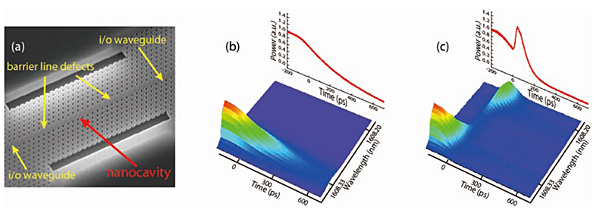 |
| (a) Scanning electron microscope image of a fabricated width-modulated line-defect photonic crystal nanocavity. The air holes in the nanocavity are shifted slightly outside the line defect. The 3D plots shown in (b) and (c) are measured spectrograms of the output light at a waveguide after it had been trapped in the photonic crystal nanocavity. The graphs behind the 3D plots are spectrally convoluted temporal waveforms. (b) Output without modulation. (c) Output when the cavity is modulated at t =0 ps. The wavelength of the trapped light shifts towards a shorter wavelength as a result of adiabatic wavelength conversion, and the light is immediately output into the waveguides and generates a short pulse. |
Short Pulse Generation by Adiabatic Wavelength Shifting
Photonic crystal nanocavities have a long photon lifetime, which enables us to manipulate photons while they are trapped. For example, we can adiabatically change the wavelength of the trapped light by changing the refractive index of the cavity, which is analogous to a vibrating string of a guitar. As a result of the adiabatic wavelength shifting of light, we can demonstrate the Q switching of a very small cavity integrated on a silicon chip. We demonstrate short pulse generation from a very high Q cavity with arbitrary timing by adiabatic wavelength shifting. This demonstration paves the way to the development of an on-chip photon memory. (Page 41)